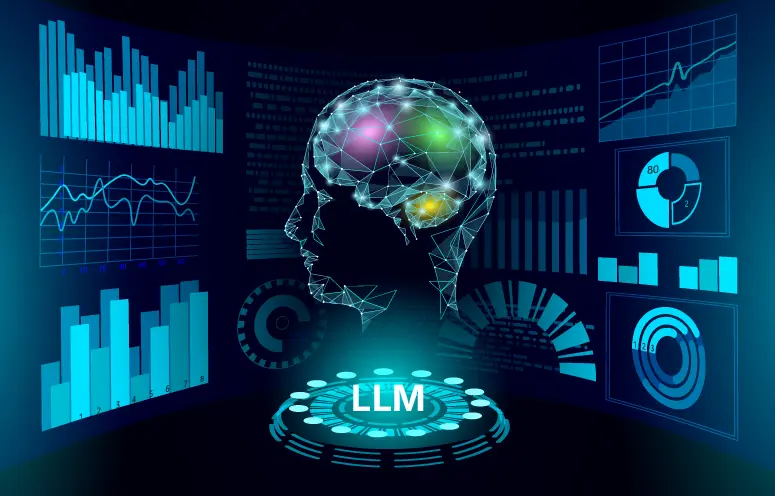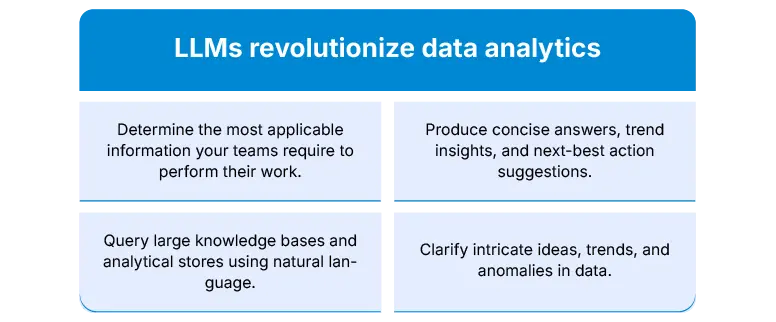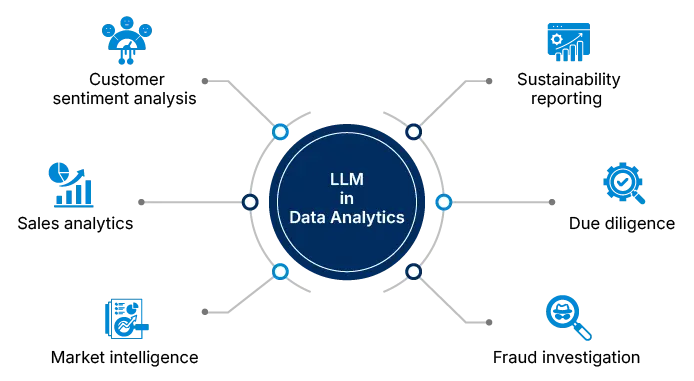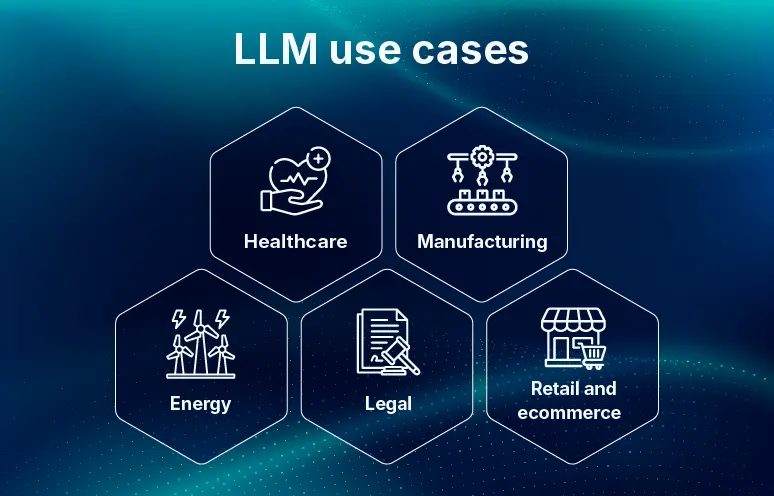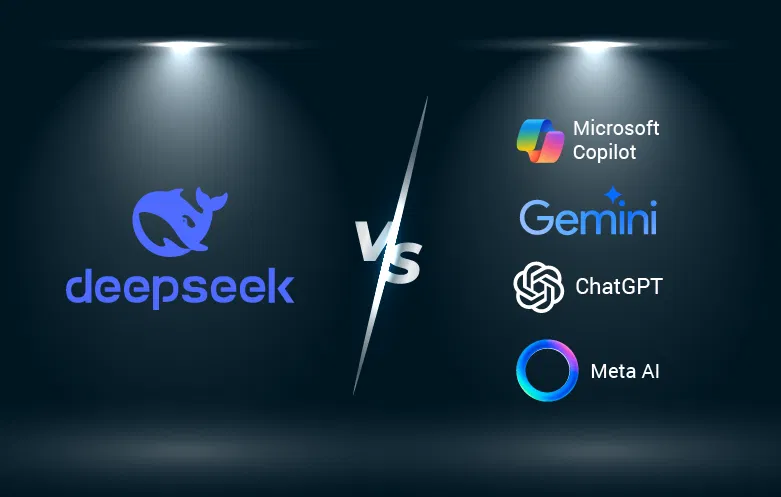Data analysis has become a cornerstone for driving smarter outcomes across business functions and sectors. As data analysis techniques continue to evolve, they are opening new possibilities for organizations to uncover hidden opportunities and make informed decisions.
The enhancements in Artificial Intelligence (AI), especially Large Language Models (LLMs), are set to augment data analysis outcomes. Specifically, multimodal LLMs can filter through a variety of data types to generate quicker and more precise actionable insights.
In this blog post, we will explore how the use of LLM for data analysis maximizes data analysis capabilities with minimal complexity and maximum returns.
How do LLMs and data analytics power data-driven workflows?
Conventional data analytics software operates on structured and numeric data. Large Language Models (LLMs), on the other hand, can understand human language and analyze sentiments, speech patterns, and particular topics from unstructured text data.
By combining LLMs with data analytics, companies can utilize additional data points, along with developing a conversational interface to investigate them.
How LLMs are revolutionizing data analytics
General-purpose LLMs such as Bidirectional Encoder Representations from Transformers (BERT) and Generative Pre-trained Transformer (GPT) were not specifically trained to execute route optimization case scenarios for various kinds of Electric Vehicles (EVs), for instance. However, due to a range of model fine-tuning methods, you can train general-purpose models to:
- Gain a better understanding of the specialized terminology in your field to interpret intricate documents
- Retrieve information from a particular dataset to offer appropriate, data-driven responses
- Format responses in various forms such as text, video, images depending on the user query
Fine-tuned LLMs enhance access to various data assets through a dialogue-based interface and enable delivering more complete, contextually appropriate insights.
Examples:
- Colgate-Palmolive employs generative AI to combine consumer and shopper information and capture consumer sentiment more accurately.
- Morgan Stanley has introduced an AI workforce assistant, which can process a variety of research questions and general admin requests.
How does an LLM-powered data analyst agent work?
Pre-trained LLMs are a strong base for creating data analyst agents powered by LLMs, providing instant capabilities without the necessity of extensive initial training. The models can be tested for task appropriateness, allowing teams to easily determine the most suitable model for their needs.
This methodology reduces time spent on data collection and preprocessing, speeding up testing and deployment. Yet, where pre-trained models are deficient in meeting domain-specific requirements, fine-tuning or custom training is required to attune the model to specialized purposes, so the data analyst agent can provide accurate and actionable results.
1. Data collection
Data is extracted from APIs, web scraping, or direct feeds, including structured and unstructured forms.
2. Data processing
- Cleaning: Maintains data quality by processing errors, duplicates, and missing values.
- Organization: Organizes data for analysis using tokenization and normalization.
- Feature extraction: Extracts attributes such as entities and sentiment through NLP processes.
3. Modeling
Pre-trained LLMs are fine-tuned for tasks, applying deep learning to comprehend language refinements.
4. Insight generation
How to make a paragraph better, using Natural Language Generation (NLG) to generate human-readable summaries and visualizations based on decision-making.
Types of LLM data analysis agent with examples
LLM agents utilize Large Language Models (LLMs) to undertake sophisticated reasoning, streamline workflows, and optimize decision-making. Applied to data analysis, LLM-driven agents can analyze enormous volumes of structured and unstructured data, identify patterns, create actionable insights, and predict future trends with minimum human interaction.
1. Natural language query agents
These agents translate user natural language queries into SQL or another database query language. These are best suited for users who do not possess technical experience in data analysis operations or querying databases.
Example: The AskData tool enables business organizations to discover answers to difficult business intelligence questions in natural language. The tool generates the relevant SQL queries automatically to obtain insights from structured datasets.
2. Predictive analytics agents
These agents utilize machine learning models incorporated with Large Language Models (LLMs) to learn from historical information and produce predictive observations. They can conduct trend analysis, spot anomalies, or recommend actions based on data patterns.
Example: DataRobot utilizes LLMs and other machine learning models to generate personalized predictive models automatically and create reports. With this tool, data scientists and analysts can focus more on interpreting results rather than developing models from scratch.
3. Data visualization agents
LLMs can be used to develop data visualizations by examining datasets and recommending the most suitable charts or graphs for data insight presentation. Such AI agents can even create code for developing interactive dashboards or reports needed while conducting exploratory data analysis.
Example: Tableau’s Ask Data, which is AI-powered, enables one to enter questions such as “Display a bar chart of sales by region,” the software automatically creates a visualization from the data.
4. Report generation agents
These agents produce text reports automatically by analyzing data. They summarize findings, trends, and insights in natural language, facilitating easy presentation of results without the need to create reports manually in the exploratory data analysis.
Example: Wordsmith is a report-writing tool that can utilize structured data and LLMs to create written summaries in simple language, ideal for business decision-makers who require high-level insights.
5. Real-time data monitoring agents
These agents track data in real-time, giving instantaneous feedback or alerts upon the analysis. They are excellent for dynamic environments where real-time data insights are paramount.
Example: Amazon CloudWatch, combined with machine learning models, provides real-time monitoring of data and automatically triggers insights or alerts based on predefined thresholds.
6. Data cleaning and preprocessing agents
These agents clean and preprocess raw data prior to predictive analysis by performing operations such as imputation of missing values, normalization of the data, and outlier detection. LLMs can automate this process by making recommendations or executing the most efficient preprocessing operations.
Example: Trifacta is a leading data-wrangling tool designed to clean, prepare, and transform raw data for analysis. It employs machine learning to inspect data, identify anomalies, and suggest or automatically perform transformations to get the dataset ready for analysis.
How LLM integration strengthens data analytics
Through the integration of the capabilities of sophisticated language processing and data analytics methods, LLMs can add depth and precision to data analytics. The insights drawn out by LLMs may be combined with structured data and utilized to support decision-making processes. A few examples of employing LLMs to augment data analytics might include:
- Customer sentiment analysis: LLMs can identify subtleties in textual information and understand the meaning of written text at a gigantic scale. They help teams discover what customers truly feel, beyond the words they use. This makes it easier to improve products and keep customers happy.
- Sales analytics: Rather than working with dashboards and SQL queries, business analysts can query CRM, ERP, and other databases through a conversational interface. This allows sales teams to get quick answers without waiting for technical help. It also helps them act faster and make smarter decisions.
- Market intelligence: By uniting textual and numerical information, business analysts can recognize emerging trends, patterns, and growth prospects. It’s like having a bird’s-eye view of where the market is headed next. Teams can plan better strategies and get ahead of their competitors.
- Sustainability reporting: LLMs can perform data extraction and management and can be set up for automatic document creation and/or verification. They make it easier to gather the right data without manual effort. This helps companies stay transparent and meet sustainability goals.
- Due diligence: LLMs help better identify risks, inconsistencies, and critical insights that leaders need to know to make better deals. They examine large volumes of text so nothing important gets missed. This helps in making fact-based decisions.
- Fraud investigation: Data analyst agents can obtain high-accuracy anomaly detection and conversational support in investigation processes through LLMs. They speed up investigations by surfacing unusual activity right away. This saves time and helps protect organizations from bigger losses.
Best platforms for data analysis using LLM
Start with clarity: what do you need solved, improved, or accelerated? Anchor your choice in that. The right tools follow clear thinking, so focus on function, and let relevance lead the way.
1. Microsoft Power BI
This market-leading analytics suite has been powered with the capabilities of generative AI. It leverages Microsoft’s Co-Pilot technology and models trained with OpenAI, including customized versions of its industry-leading GPT-4 models.
The platform combines many technologies, such as Microsoft’s Fabric AI-driven analytics platform and Azure Synapse, so that it can be integrated with data warehouse and other big data technologies such as Apache Spark. This brings an end-to-end analytics solution appropriate for the most enterprise-scale workloads, to support anything from basic analytics to creating and deploying your machine learning models on Azure. It’s an enterprise user-friendly option that supports flexible cloud integrations and handles large data workloads.
2. Tableau Pulse
Tableau is among the top data visualization tools used globally. It features Tableau Pulse, which is developed on Salesforce’s Einstein models, for AI-driven insights. Its Insights Platform enables automated analysis of datasets to derive insights and trends in natural language while creating visualizations.
The bundle is designed to drive decision-making and enhance productivity by enabling business users to access rich analytics at their fingertips. Security and privacy are paramount when handling data; hence Salesforce has combined its Einstein Trust Layer guardrails with Tableau Pulse for assurance. This tool is suitable for decision-makers who want to build user-friendly and rich visualizations.
3. Qlik
Qlik is a well-established data and analytics platform that now allows users to embed generative AI analytics content in their dashboards and reports via its Qlik Answers assistant. It includes automatic summaries of important data points, natural language reporting and several integrations with third-party tools and platforms.
It focuses on explainability to ensure that insights can always be backed up with sources and citations. Qlik’s platform is especially beneficial for customers who want to analyze vast amounts of unstructured data, such as text or video.
4. Transformer-XL
Established by Google AI researchers, Transformer-XL is another popular open-source Large Language Model (LLM) which solves the limitations of conventional Transformers in dealing with long-range dependencies. Transformer-XL presents a novel architecture capable of capturing context beyond fixed-length sections.
With recurrence mechanisms like relative positional encodings and memory states, Transformer-XL can effectively process and comprehend sequence of any length up to 80% longer than traditional models. This enables the model to excel in long-range dependency tasks like document understanding, language modeling, and machine translation.
5. GPT
GPT is a type of large language model developed to understand and generate human-like text. It’s trained on massive amounts of data. It uses deep learning to predict and construct language patterns. GPT interprets context and produces comprehensible, relevant responses to perform various tasks, such as answering questions, summarizing content, generating code, or assisting with writing. Its strength lies in adaptability, which makes it useful throughout industries.
How are LLMs for data analytics applied across various industries?
LLMs bring structure to massive, messy datasets across industries. They turn unstructured data into clear insights, automate complex analysis, and accelerate decision cycles. It helps teams act faster, reduce risk, and improve operational clarity.
- Supply chain: LLMs analyze logistics data such as shipment status and delivery timelines. It identifies demand signals, predicts delivery delays, optimizes inventory and route decisions, and generates actionable insights.
- Manufacturing: Production data such as sensor readings, quality inspection results, and maintenance logs are analyzed using LLM to detect quality issues, predict equipment failures, optimize workflows, and improve production planning.
- Finance: LLMs examine transaction data and analyze market sentiment to detect fraud patterns, forecast risk, and generate investment reports.
- Retail: Businesses use LLMs to analyze customer behavior and sales trends, optimize pricing strategies and inventory movement, and improve stock and pricing accuracy.
- Telecom: LLM is used in the telecom industry to analyze traffic, outage patterns, and customer usage data. It optimizes infrastructure investments and automates responses to technical support inquiries efficiently.
- Healthcare: Clinical records are processed using LLM to identify treatment patterns, predict disease outbreaks, summarize research findings, and generate insights for faster decision-making.
- Semiconductor: LLMs analyze fabrication data to identify defect patterns, optimize yield rates, predict equipment maintenance needs, and extract insights from complex manufacturing process parameters.
The future of LLMs and data analytics
As data analytics continues to progress, the use of LLMs is full of potential for future advances. LLMs and data analytics will see several advancements to further advance and make their impact felt across various industries.
-
Better language comprehension
Future technology developments in LLMs will continue to emphasize enhancing language understanding abilities. LLMs will learn to better identify context, sarcasm, idioms, and other aspects of language.
-
Multilingual and cross-cultural analysis
LLMs are currently trained on several languages, but future technology will probably enhance their multilingual analysis. This will allow companies to analyze and learn from text data across different languages, making global operations and cross-cultural analysis possible.
-
Real-time analysis
The future of LLMs for data analytics will be associated with capabilities of real-time analysis. LLMs will be equipped to analyze and process textual data in real-time, enabling businesses to react in a timely manner to new trends, customer comments, and market forces.
-
Integration with other data analytics techniques
Upcoming advancements will emphasize the convergence of LLM-created insights with other data analytics methods. By using LLMs in conjunction with conventional statistical models, machine learning algorithms, and predictive analytics, companies can leverage each method’s strengths and build more precise predictive models.
-
Ethical and bias considerations
With the growing use of LLMs in data analysis, there will be greater emphasis on ethical issues and resolving biases. New advancements will enhance transparency and equity in LLM algorithms to make sure they do not reinforce biases or discriminate against particular groups.
Empowering human intuition with AI support
LLMs help people focus on what they do best, thinking clearly and making smart decisions. By reducing the cognitive load of sifting through vast information, LLMs free up space for decision-makers to focus on nuance, creativity, and instinct.
The goal isn’t to replace expertise, it’s about enabling professionals to bring their full insight to the table, supported by fast, accurate input. As more teams begin to use LLMs as collaborative partners, they’ll find that these tools accelerate processes and amplify human potential. Connect with our AI experts to understand how integrating an LLM model can help in enhancing your business growth.
